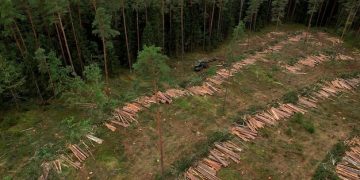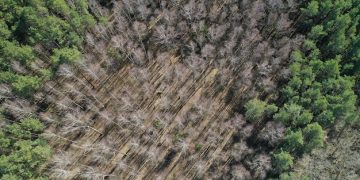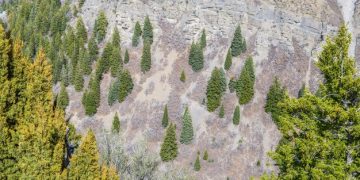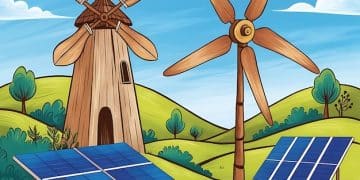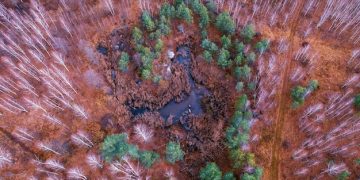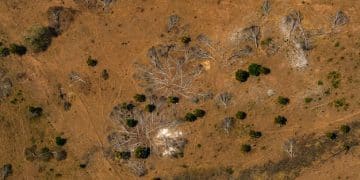Deforestation and Flooding Risk: Is Your US Community Safe?

Deforestation in the US significantly elevates the risk of flooding by reducing natural water absorption, destabilizing soil, and overwhelming drainage systems, thereby jeopardizing communities.
Is your community prepared for the next big flood? Deforestation and increased flooding: Is your US community at risk? It’s a question more and more Americans are asking as they witness the devastating effects of unchecked deforestation on local ecosystems.
Understanding the Link Between Deforestation and Flooding
The relationship between deforestation and increased flooding is more direct than many realize. Forests play a crucial role in water management. They act as natural sponges, absorbing rainfall and gradually releasing it into the groundwater and waterways. When forests are cleared, this natural buffering capacity is lost, leading to increased runoff and a greater risk of flooding.
How Forests Naturally Prevent Flooding
Forests mitigate flooding in several key ways. Their canopy intercepts rainfall, reducing the force with which it hits the ground. The root systems bind the soil together, preventing erosion and increasing the soil’s ability to absorb water. The organic matter on the forest floor also acts as a sponge, soaking up water and slowing its flow.
- Interception: Tree canopies catch rainfall, diminishing its impact on the ground.
- Absorption: Root systems enhance soil absorption capacity.
- Erosion Control: Roots bind the soil, preventing erosion.
- Slowing Runoff: Forest floors rich in organic matter hold and release water gradually.
Consider the Mississippi River Basin, where extensive deforestation over the past century has contributed to increasingly severe flooding events. The removal of bottomland hardwood forests, which once acted as natural floodplains, has left communities more vulnerable to rising waters.

The loss of these natural protections not only increases the frequency and severity of floods but also has significant economic consequences. Homes and businesses are damaged, infrastructure is destroyed, and agricultural lands are inundated, leading to crop losses and food shortages.
Essentially, the destruction of forests impairs the environment’s ability to regulate water flow, making communities much more vulnerable to flooding.
Deforestation Hotspots in the US and Their Flood Vulnerability
While deforestation is a global issue, certain regions in the US are particularly vulnerable due to their historical patterns of forest clearing and their exposure to severe weather events. Identifying these hotspots can help policymakers and local communities prioritize conservation efforts and implement flood mitigation strategies.
Areas at High Risk
Several areas across the US are facing increased flood risks due to deforestation. The Pacific Northwest, with its history of logging, is experiencing more frequent and intense flooding events. Similarly, the Southeast, particularly the Appalachian region, has seen significant forest loss due to mining and development, increasing its vulnerability.
In the Gulf Coast, the clearing of coastal forests and wetlands has exacerbated the impacts of hurricanes and tropical storms, leading to devastating floods. The Midwest, with its extensive agricultural lands, has also experienced increased runoff and flooding due to the conversion of forests to farmland.
- Pacific Northwest: Logging history contributes to frequent flooding.
- Southeast (Appalachian Region): Mining and development cause forest loss and increase susceptibility to floods.
- Gulf Coast: Coastal forest removal intensifies hurricane and storm impacts.
- Midwest: Forest conversion to agriculture leads to increased runoff.
For example, in the Appalachian region, the removal of forests for coal mining has destabilized the land, leading to increased erosion and runoff. During heavy rainfall, the water quickly overwhelms drainage systems, causing flash floods that can inundate communities downstream.
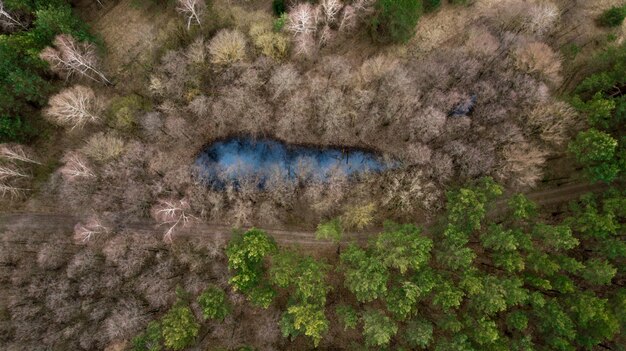
These hotspots are not only ecologically vulnerable but also economically and socially at risk. Communities in these regions often rely on natural resources for their livelihoods, and the destruction of forests can have cascading effects on their well-being.
Identifying where deforestation is most acute allows for targeted conservation and mitigation strategies.
The Role of Extreme Weather in Exacerbating Flood Risks
Climate change is not only contributing to more frequent and intense extreme weather events but is also compounding the impacts of deforestation on flood risks. As temperatures rise and precipitation patterns shift, the vulnerability of communities to flooding is further amplified.
Climate Change and Increased Rainfall
One of the most significant ways climate change exacerbates flood risks is through increased rainfall. Warmer temperatures lead to greater evaporation, resulting in more moisture in the atmosphere. This, in turn, leads to heavier and more prolonged rainfall events, overwhelming natural and built drainage systems.
In areas that have already experienced deforestation, the increased rainfall amplifies the effects of reduced water absorption and increased runoff. This can lead to more frequent and severe flooding, causing widespread damage and displacement.
Consider the impact of Hurricane Harvey in 2017, which caused unprecedented flooding in Houston, Texas. The combination of heavy rainfall and extensive urbanization, which replaced natural vegetation with impervious surfaces, overwhelmed the city’s drainage systems and led to catastrophic flooding.
Moreover, climate change is also contributing to more frequent and intense heatwaves, which can dry out soils and vegetation, reducing their ability to absorb water. This, in turn, can increase the risk of flash floods during heavy rainfall events.
The interaction between extreme weather and deforestation creates a synergistic effect, magnifying the flood risks faced by communities across the US.
Community-Level Impacts: Stories from Affected Regions
The impacts of deforestation and increased flooding are not just abstract statistics; they are lived experiences for communities across the US. Hearing directly from those affected can provide a more comprehensive understanding of the challenges they face and the solutions they are pursuing.
Personal Accounts of Flood Damage
In the Appalachian region, residents have witnessed firsthand the devastating effects of flash floods caused by deforestation from coal mining. Homes have been inundated, roads washed out, and entire communities have been displaced.
In the Pacific Northwest, logging operations have contributed to increased runoff and flooding, damaging salmon habitats and disrupting local fisheries. Indigenous communities, who rely on these resources for their livelihoods, have been particularly affected.
- Appalachian Region: Flash floods from mining-related deforestation damage homes and displace communities.
- Pacific Northwest: Logging increases runoff, harming salmon habitats and disrupting fisheries.
The economic impacts of these flooding events can be significant, particularly for low-income communities who may lack the resources to recover. Many residents are forced to relocate, disrupting social networks and weakening community bonds.
Moreover, the psychological toll of repeated flooding events can be severe, leading to increased stress, anxiety, and depression. The constant threat of flooding can also erode trust in local government and institutions.
These stories highlight the urgent need for comprehensive solutions that address both the root causes of deforestation and the immediate impacts of flooding.
Mitigation Strategies: What Can Be Done to Protect Communities
Addressing the risks of deforestation and increased flooding requires a multi-faceted approach that combines conservation efforts, sustainable land management practices, and community-based adaptation strategies. By working together, policymakers, landowners, and local communities can protect themselves from the devastating impacts of flooding.
Effective Strategies for Flood Prevention
One of the most effective strategies for preventing flooding is to conserve and restore forests. This involves protecting existing forests from logging and development, as well as reforesting degraded areas. In urban areas, planting trees and creating green spaces can also help reduce runoff and mitigate the impacts of flooding.
Sustainable land management practices, such as reduced-impact logging and conservation agriculture, can also help reduce erosion and runoff. These practices prioritize the health of the soil and vegetation, ensuring that they continue to provide valuable ecosystem services.
Community-based adaptation strategies, such as building flood-resistant homes and restoring natural floodplains, can also help reduce the impacts of flooding. These strategies involve working with local communities to identify their vulnerabilities and develop solutions that are tailored to their specific needs.
- Forest Conservation and Restoration: Protect existing forests and reforest degraded areas.
- Sustainable Land Management: Use reduced-impact logging and conservation agriculture.
- Community-Based Adaptation: Build flood-resistant homes and restore natural floodplains.
For example, in some communities, residents have worked together to create community gardens and green spaces that absorb rainfall and reduce runoff. These efforts not only help prevent flooding but also provide valuable social and recreational benefits.
Ultimately, protecting communities from the risks of deforestation and increased flooding requires a holistic approach that recognizes the interconnectedness of ecosystems, economies, and societies.
Policy and Advocacy: Driving Change at a Larger Scale
While local efforts are crucial, addressing the root causes of deforestation and increased flooding requires policy changes and advocacy at a larger scale. Governments, businesses, and non-profit organizations all have a role to play in promoting sustainable land management and protecting communities from flooding.
Policies to Support Forest Preservation
One of the most important steps governments can take is to enact policies that support forest preservation. This includes strengthening regulations on logging and development, as well as providing incentives for landowners to conserve their forests. Governments can also invest in research and education to promote sustainable land management practices.
Businesses can also play a role by adopting sustainable sourcing practices and reducing their reliance on products that contribute to deforestation. Consumers can support these efforts by choosing products that are certified as sustainably produced.
Non-profit organizations can advocate for policy changes, raise awareness about the risks of deforestation and flooding, and provide technical assistance to communities seeking to implement mitigation strategies.
- Government Policies: Strengthen logging regulations and incentivize forest conservation.
- Business Practices: Adopt sustainable sourcing and reduce deforestation-linked products.
- Non-profit Advocacy: Promote policy changes and raise awareness.
For instance, organizations like the Nature Conservancy work to protect ecologically important lands and waters, partnering with communities, businesses, and governments to achieve conservation goals.
By working together, these actors can create a more sustainable future where communities are protected from the devastating impacts of deforestation and increased flooding.
| Key Aspect | Brief Description |
|---|---|
| 🌳 Deforestation | Increases flood risk by reducing water absorption and accelerating runoff. |
| 🌧️ Extreme Weather | Climate change intensifies rainfall, worsening flood impacts. |
| 🏘️ Community Impact | Floods damage homes and displace communities. |
| 🛡️ Mitigation | Conservation, sustainable management, and adaptation strategies. |
Frequently Asked Questions (FAQ)
Deforestation removes trees that naturally absorb water. Without these trees, rainwater quickly runs off into rivers and streams, leading to increased flooding as the ground’s natural absorption ability diminishes.
The Pacific Northwest, Southeast (Appalachian Region), Gulf Coast, and Midwest are especially vulnerable due to historical logging, mining, coastal forest removal, and forest-to-agriculture conversions.
Climate change increases rainfall intensity and frequency. In deforested areas, this leads to more runoff and more severe flooding, overwhelming natural and built drainage systems more easily.
Effective strategies include building flood-resistant homes, restoring natural floodplains, and creating community gardens and green spaces. These solutions address flooding risks directly at a local level.
Strengthening logging regulations, providing incentives for landowners to conserve forests, and promoting sustainable land management practices can all drastically support forest preservation and reduce flood risks.
Conclusion
The connection between deforestation and increased flooding: is your US community at risk? is undeniable and growing more critical with each passing year. Communities must prioritize forest conservation, adopt sustainable land management practices, and advocate for policies that protect their natural resources and safeguard their futures from the increasing threat of floods. By taking action now, the US can protect its communities and ecosystems from the devastating consequences of deforestation and climate change.
